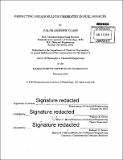Predicting organosulfur chemistry in fuel sources
Author(s)
Class, Caleb Andrew
DownloadFull printable version (17.35Mb)
Other Contributors
Massachusetts Institute of Technology. Department of Chemical Engineering.
Advisor
William H. Green.
Terms of use
Metadata
Show full item recordAbstract
Desulfurization of fossil fuels with supercritical water (SCW) has been the topic of many studies over the past few decades. This process does not require the use of any catalyst, eliminates the need for a hydrogen feed, and minimizes coke formation. Previous research has shown that it has the potential to be a viable commercial process, and recent experimental studies have proven that water acts as one hydrogen source for sulfur removal in this process. However, the exact desulfurization mechanism is largely unknown, as are many other reaction mechanisms involving sulfur compounds. Recent work has greatly expanded our ability to build comprehensive reaction mechanisms automatically for the decomposition of organic sulfur compounds using the automated Reaction Mechanism Generator (RMG). This thesis presents the implementation of this and other tools to investigate chemical processes relevant to our use of fuel sources containing sulfur compounds, and it shows some steps that have been taken to improve our predictions for these mechanisms and those that will be generated in the future. Previous investigations had focused on the pyrolysis of small sulfur compounds containing less than six heavy atoms, so RMG is first used to study the pyrolysis of t-butyl sulfide. A detailed reaction mechanism is then presented for the SCW desulfurization of hexyl sulfide. Comprehensive kinetic mechanisms for these larger molecules are likely to include thousands of reactions, so RMG builds this model in a systematic and unbiased way using a database of ab initio data. This database is expanded with potentially relevant thermochemical and kinetic parameters using transition state theory and quantum chemical calculations at the CBS-QB3 and CCSD(T)-F12 levels of theory. With these data, as well as previously calculated rates for hydrocarbon and sulfur kinetics, RMG is used to build a reaction mechanism for the conversion of hexyl sulfide to hydrogen sulfide, pentane, and carbon monoxide in the presence of SCW. This mechanism is validated with results from batch and flow reactor experiments, and predictions are accurate within a factor of two for reactant and major product concentrations. Analysis of the proposed mechanism shows that the molecular addition of water to the carbonsulfur double-bond in hexanethial is a key step in the SCW process, as this not only leads to the desulfurization of the compound, but also prevents the thioaldehyde from undergoing addition reactions with other hydrocarbons in a process that could eventually form coke. Thus, this work not only has implications in the SCW desulfurization process, but in the overall crude oil upgrading process as well. The calculated kinetic and thermochemical parameters are used to generate predictive reaction mechanisms for other processes relevant in fuel chemistry, such as the geological formation of oil and gas from kerogen. This not only allows us to model experimental work investigating the effect sulfur compounds have on the oil-to-gas process, but we also explore how these effects differ at geological conditions and timescales. And as the possible applications of RMG grow, the need for accurate parameters in mechanism generation become even more critical. A thermochemical database is generated for a wide variety of sulfur compounds using the highaccuracy CCSD(T)-F12/cc-pVTZ-F12 method, and this provides a basis for the investigation of organosulfur chemistry with tighter uncertainty.
Description
Thesis: Ph. D., Massachusetts Institute of Technology, Department of Chemical Engineering, 2015. Cataloged from PDF version of thesis. Includes bibliographical references.
Date issued
2015Department
Massachusetts Institute of Technology. Department of Chemical EngineeringPublisher
Massachusetts Institute of Technology
Keywords
Chemical Engineering.